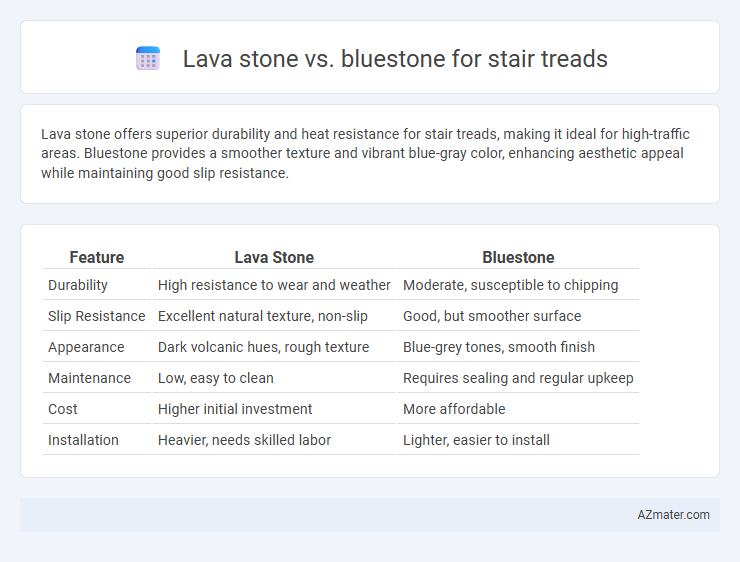Lava stone offers superior durability and heat resistance for stair treads, making it ideal for high-traffic areas. Bluestone provides a smoother texture and vibrant blue-gray color, enhancing aesthetic appeal while maintaining good slip resistance.
Table of Comparison
| Feature | Lava Stone | Bluestone |
|---|---|---|
| Durability | High resistance to wear and weather | Moderate, susceptible to chipping |
| Slip Resistance | Excellent natural texture, non-slip | Good, but smoother surface |
| Appearance | Dark volcanic hues, rough texture | Blue-grey tones, smooth finish |
| Maintenance | Low, easy to clean | Requires sealing and regular upkeep |
| Cost | Higher initial investment | More affordable |
| Installation | Heavier, needs skilled labor | Lighter, easier to install |
Introduction to Lava Stone and Bluestone Stair Treads
Lava stone stair treads offer exceptional durability and heat resistance, characterized by a porous texture and volcanic origin that ensures a natural, slip-resistant surface ideal for high-traffic areas. Bluestone stair treads, composed mainly of sandstone or basalt, provide a dense, fine-grained structure with rich blue-gray hues, enhancing outdoor and indoor staircases with their weather-resistant and low-maintenance properties. Both materials excel in aesthetic appeal and functional performance, but lava stone's rugged texture contrasts with bluestone's smooth, uniform finish.
Material Origins and Composition
Lava stone, formed from rapidly cooled molten lava, is characterized by its porous texture and high iron content, offering durability and natural heat resistance ideal for stair treads. Bluestone, a dense sedimentary rock primarily composed of sandstone and dolomite, originates from ancient riverbeds and provides a smooth texture with excellent load-bearing properties. Both materials boast unique compositions that influence their aesthetic appeal and structural integrity in stair applications.
Visual Appearance and Color Variations
Lava stone stair treads offer a rich, deep, and slightly porous texture with natural black to dark gray hues, providing a dramatic and bold visual impact. Bluestone, known for its smooth finish, comes in a wider range of colors including blue-gray, tan, and olive, allowing for greater versatility in design aesthetics. The color variations in bluestone create a subtle, elegant appearance, while lava stone's darker tones emphasize a more rustic and intense look for staircases.
Durability and Strength Comparison
Lava stone exhibits exceptional durability and high compressive strength, making it highly resistant to wear and ideal for heavy foot traffic on stair treads. Bluestone, while durable, typically has lower compressive strength and may be more susceptible to chipping or cracking under heavy loads compared to lava stone. For stair treads, lava stone offers superior longevity and strength, ensuring a robust and long-lasting surface.
Slip Resistance and Safety Features
Lava stone for stair treads offers excellent slip resistance due to its naturally rough and porous surface, making it ideal for wet or outdoor environments. Bluestone provides a smoother texture but is often treated or honed to enhance grip, balancing aesthetic appeal with safety. Both materials are durable, but lava stone's intrinsic texture generally outperforms bluestone in slip resistance, reducing accident risks on stairs.
Weather Resistance and Outdoor Performance
Lava stone offers superior weather resistance due to its volcanic origin, making it highly durable against extreme outdoor conditions such as frost, heavy rain, and intense sunlight. Bluestone, a dense sandstone, provides excellent slip resistance and moderate weather durability but may require sealing to prevent water absorption and erosion over time. For outdoor stair treads, lava stone generally delivers longer-lasting performance with minimal maintenance, while bluestone offers aesthetic appeal with occasional upkeep needs.
Maintenance and Cleaning Requirements
Lava stone stair treads require minimal maintenance due to their dense, non-porous surface, which resists stains and moisture effectively. Bluestone, while durable, is more porous and demands regular sealing and careful cleaning to prevent staining and surface deterioration. Both materials benefit from routine sweeping and gentle cleaning with pH-neutral detergents to maintain their appearance and longevity.
Installation Process and Compatibility
Lava stone stair treads offer straightforward installation due to their uniform density and natural cleft surface, ensuring strong adhesion with standard mortar and concrete substrates. Bluestone requires careful surface preparation because of its variable porosity and occasional layering, which can impact bonding and necessitate specialized sealants or bonding agents. Compatibility-wise, lava stone performs well in both interior and exterior stairs with high foot traffic, while bluestone is better suited for sheltered or decorative installations where moisture exposure is minimized.
Cost Comparison and Long-term Value
Lava stone stair treads typically have a higher upfront cost compared to bluestone due to their rarity and unique texture. Bluestone offers a more budget-friendly option with reasonable durability, but lava stone provides superior long-term value through enhanced resistance to wear, weather, and staining. Over time, lava stone's low maintenance and increased longevity can offset its initial price, making it a cost-effective choice for high-traffic areas.
Best Applications: Choosing the Right Stone for Your Stairs
Lava stone's high durability and slip resistance make it ideal for outdoor stair treads exposed to harsh weather and heavy foot traffic, while bluestone's smooth texture and elegant appearance suit indoor staircases or covered porches requiring a refined finish. Bluestone offers excellent resistance to freeze-thaw cycles, making it suitable for climates with fluctuating temperatures, whereas lava stone excels in heat retention, benefiting steps in sun-exposed areas. Selecting between lava stone and bluestone depends on your stair location, environmental conditions, and aesthetic preferences to ensure optimal performance and safety.

Infographic: Lava stone vs Bluestone for Stair tread
 azmater.com
azmater.com